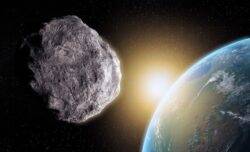‘Planet killer’ asteroids are those more than a kilometre wide (Picture: Getty)
Humans won’t be going the way of the dinosaurs for at least 1,000 years, according to a new study of large asteroids lurking nearby.
Researchers at the University of Colorado, Boulder, and Nasa have analysed almost 1,000 near-Earth objects (NEOs) larger than a kilometre in size – but unlike typical modelling that assesses their risk over a century, the team has looked ahead a millennia.
‘In general, asteroid impacts capable of causing significant damage to Earth are extremely unlikely,’ said Nasa’s Dr Davide Farnocchia, speaking to the MIT Technology Review. ‘Just in case, we are doing our due diligence.
‘We came up with a less computationally intense approach to take a peek at a longer time interval.’
Around 3,000 new NEOs are discovered every year by survey telescopes scanning the night sky for potential threats.
However, while asteroids follow knowable orbits around the Sun, small uncertainties in their position can have a major effect on their trajectory, as can the gravitational effects of nearby planets. This requires careful monitoring and path prediction.
To view this video please enable JavaScript, and consider upgrading to a web
browser that
supports HTML5
video
Dr Farnocchia, from Nasa’s Center for Near Earth Object Studies at the Jet Propulsion Laboratory in California, said that by identifying the small portion of each asteroid’s orbit that would bring it close to Earth, they could assess the chance of an impact over a much longer timescale.
‘It’s good news,’ said lead author Oscar Fuentes-Muñoz, from the University of Colorado, Boulder. ‘As far as we know, there’s no impact in the next 1,000 years.’
The study, which has been accepted for publication in the Astronomical Journal, identified the asteroid with the highest risk of a collision. Named 1994 PC1, the kilometre-wide stony asteroid was found to have a 0.000151% chance of passing within the orbit of the Moon – ten times the risk posed by any other asteroid studied.
How many asteroids are out there?
According to Nasa, there are 1,282,699 known asteroids.
Sometimes called minor planets, they are rocky, airless remnants left over from the early formation of the solar system about 4.6billion years ago. Most are found in the asteroid belt between Mars and Jupiter.
The largest known asteroid is Vesta, about 329miles wide.
The total mass of all the asteroids combined is less than that of Earth’s Moon.
Source: Nasa
‘It’s still not likely that it’s going to collide,’ said Fuentes-Muñoz. ‘But it will be a very good scientific opportunity, because it’s going to be a huge asteroid that’s very close to us.’
However, the study has not assessed smaller asteroids still capable of destroying a city, those larger than 140m across. Fuentes-Muñoz told The MIT Technology Review Nasa’s catalogue of such NEOs is about 40% complete.
‘It depends on how many there are, which is really uncertain,’ he said. ‘We’re not sure. But there’s hope that new surveys of the sky will give us a much higher completeness rate.’
The last complete image of the asteroid moonlet Dimorphos, taken two seconds before Nasa crashed a spacecraft into it (Picture: Reuters)
Last year Nasa successfully tested its planetary defence system Double Asteroid Redirection Test (Dart), smashing a rocket into an asteroid and changing its trajectory.
Just in case.
MORE : Images reveal aftermath of Nasa spacecraft crashing into asteroid
MORE : Asteroid explodes over the Channel creating flash seen as far as Wales and Paris
We won’t be following the dinosaurs just yet.





